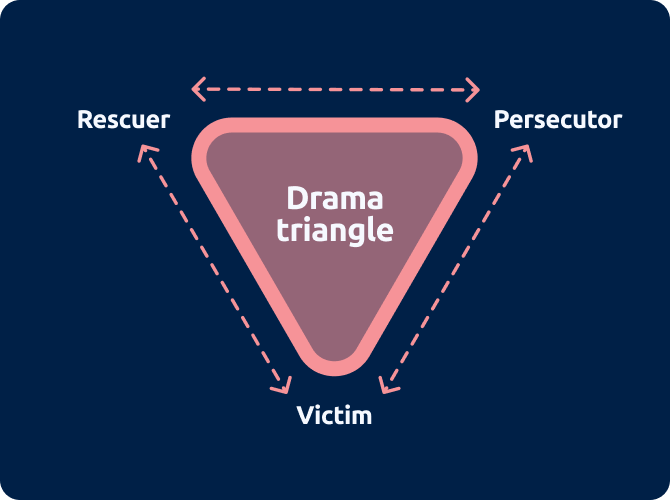What’s with all the drama?
Do you sometimes struggle with feeling manipulated, controlled, or guilty in your relationships? It can feel overwhelming and like you’re stuck in a constant power struggle.
It doesn’t have to be this way though. There is a way out, but the best place to start is by understanding what is really going on beneath the relational drama. From there you can focus on how to free yourself from these destructive behaviour patterns.
Stephen Karpman’s Drama Triangle (1966) is a useful tool for unpacking these unhealthy relationship dynamics. It states that there are three “life narratives” or ways of interacting that produce drama. Now when you read ‘drama’, insert your own unhealthy relationship dynamics. It could be conflict, tension, frustration, relational strain, passive aggression, guilt-tripping, the silent treatment…
These are the three narratives or roles and how they play out:
Victim
View of self
I am weak, abused and need saving.
Underlying belief
I don’t have what it takes to fix my problems, someone else must.
Action
Disempowered and needy.
Rescuer
View of self
I have to solve, fix and help others.
Underlying belief
I can fix you and I always know what’s best.
Action
Seek out others to save.
Persecutor
View of self
I must uphold my ideals, values, and convictions.
Underlying belief
I have to appear right and perfect in order to feel safe.
Action
Blame, accuse and judge others.
How can I break free?
- the Victim into a Creator
- the Persecutor into a Challenger
- the Rescuer into a Coach
Creator
New underlying beliefs
- I am sufficient, whole and complete.
- I am responsible for choosing my responses to life.
- I can focus on learning and improving, even when faced with struggles and setbacks.
Guiding growth question
If I had free choice in this matter, what options might I create?
Coach
New underlying beliefs
- I have faith in the wisdom that lies within.
- I trust the discovery process.
- I believe in leaving the power with others as they clarify what they want.
Guiding growth question
Challenger
New underlying beliefs
- Life is about learning and growth – even in the face of “not knowing”.
- Given that life is ever-changing and uncertain, I rest in the confidence and conviction of my values.
- I tell the truth about current reality, without blame or judgement.
Guiding growth question
Want to learn more? Start here…
What is Emotional Intelligence?
Soft is Hard: Discovering the importance of developing your power skills
Reference list
-
Karpman, S. (1966). Fairy tales and script drama analysis. Transactional Analysis Bulletin, 7(26), 39-43.
Emerald, D. (2015). The Power of TED* (*The Empowerment Dynamic). Polaris.


